Small-Ship Cruise News Highlights
by Anne Kalosh
Small ships had an outsized presence at Seatrade Cruise Global, cruising’s largest annual B2B gathering held in Miami Beach, Florida, in late April (2022).
Expedition, river and yacht cruises are a dynamic aspect of the business, with a parade of new vessels in recent years.
And, with the pandemic-induced zeitgeist of avoiding crowds, the desire for fresh air and the great outdoors, and a focus on more meaningful intimate and experiences, it’s no wonder Quirky-sized ships are having their day.
Here are some small-ship cruise news highlights from the Seatrade event.
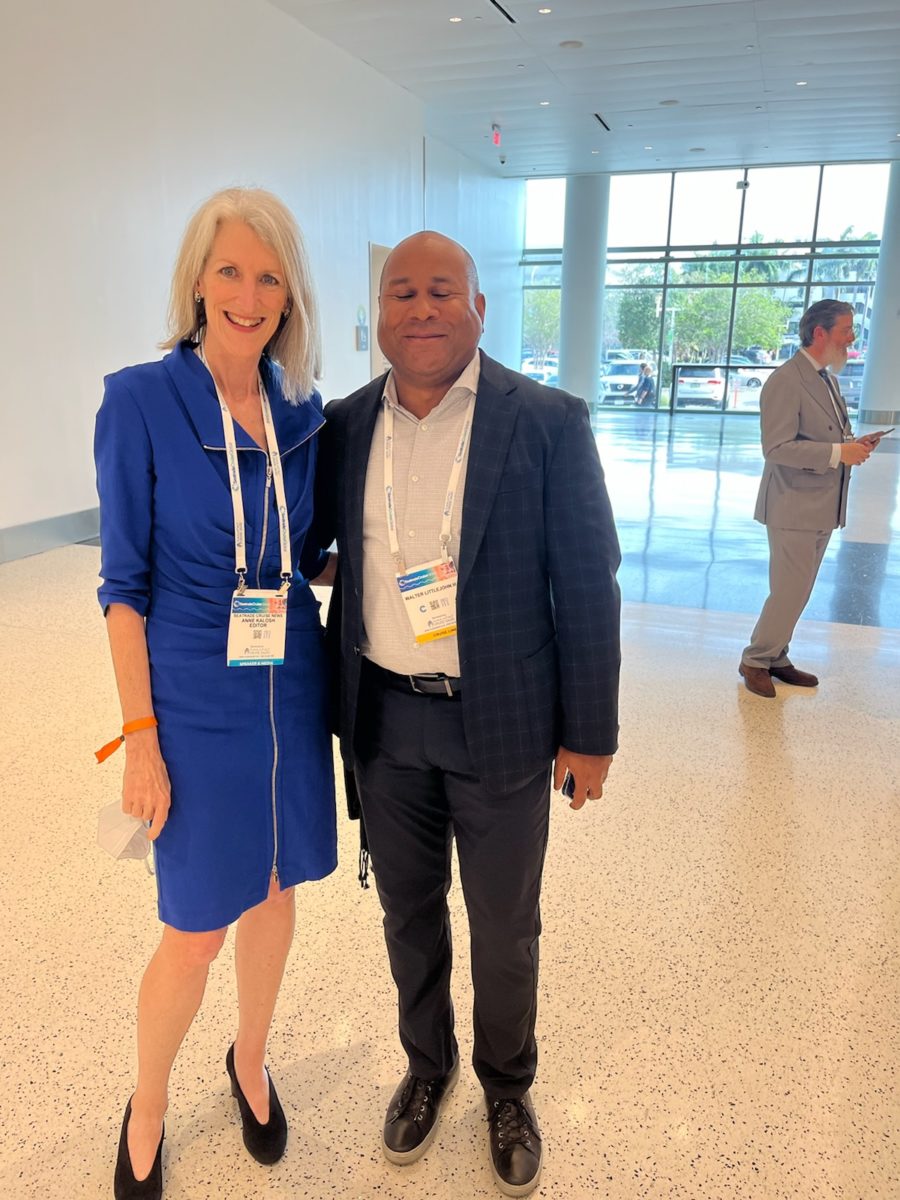
Anne Kalosh, left, at Seatrade with Walter Littlejohn, former managing director of Crystal River Cruises.
New River Cruise Line
A new European river cruise line exclusively for group charters was announced.
Transcend Cruises will cater to corporate meetings, events and incentive travel, affinity and alumni groups, family groups like wedding parties, tour operators, lifestyle brands, travel agencies’ groups and other companies marketing trips under their own brand.
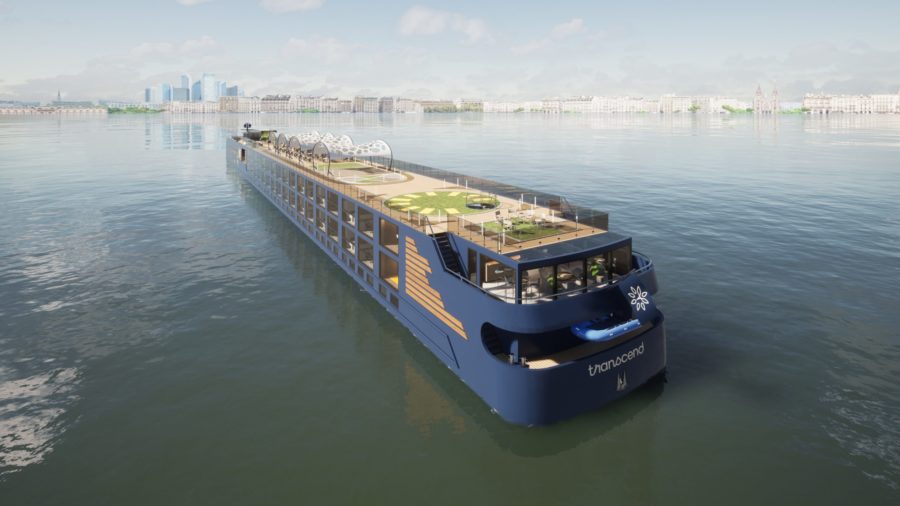
Transcend Cruises was announced as a new European river line exclusively focused on groups. * Rendering: Transcend Cruises
Co-founder and CEO Matthew Shollar’s travel industry background includes founding Chosen Voyage, a company that chartered vessels for kosher cruises.
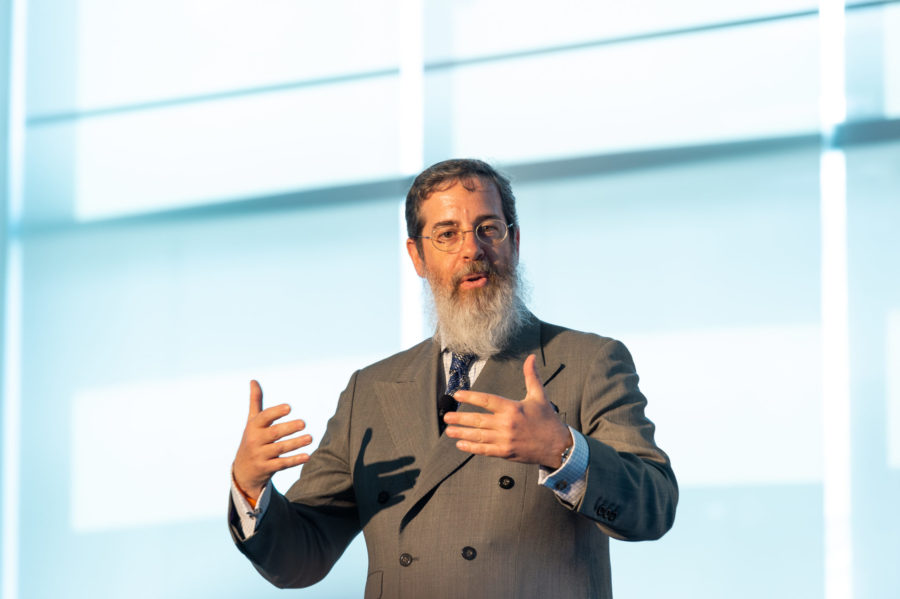
Matthew Shollar announces Transcend Cruises at a news conference. * Photo: Seatrade Cruise Global
The lack of a customized charter product, coupled with strong demand for smaller, experiential group travel that intensified during the pandemic, convinced Shollar that “the market opportunities are immense.
“We are introducing a new category … with wellness-enabled, luxurious river cruising venues, providing unmatched support to our clients, all while expanding the market to audiences that typically have only considered hotels and resorts,” Shollar said during a Seatrade news conference.
Transcend Cruises envisions at least a dozen vessels with cutting-edge sustainability features over the first six years. The first is to enter service in April 2024 on the Rhine before switching to the Danube in June.
While the vessels will measure the European-standard 135 meters, they’ll carry 30 percent to 50 percent fewer passengers. Up to 120 cruisers can be accommodated in oversized staterooms, all with French balconies, or up to 60 in two-room, two-bath suites. The number of rooms or suites will be customized for the charterer.
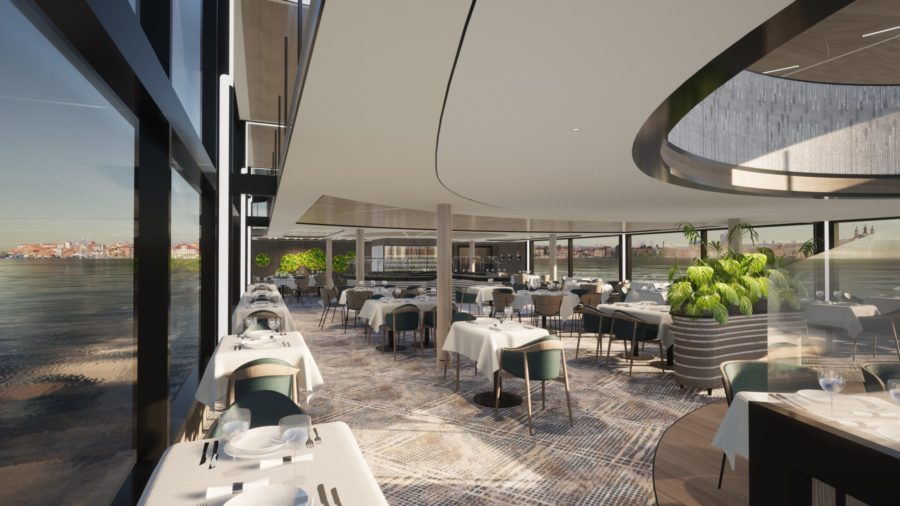
Big windows and airy spaces characterize Transcend’s planned river vessels. Here, the dining room. * Rendering: Transcend Cruises
The light-filled public spaces are designed for groups, with five venues that accommodate all travelers, as well as intimate settings for events, dining, presentations and breakouts. There will be a 2,600-square-foot indoor/outdoor fitness, spa and guest wellness facility — the largest on the rivers.
At other news conferences, American Cruise Lines President/CEO Charles B. Robertson provided more details about Project Blue.
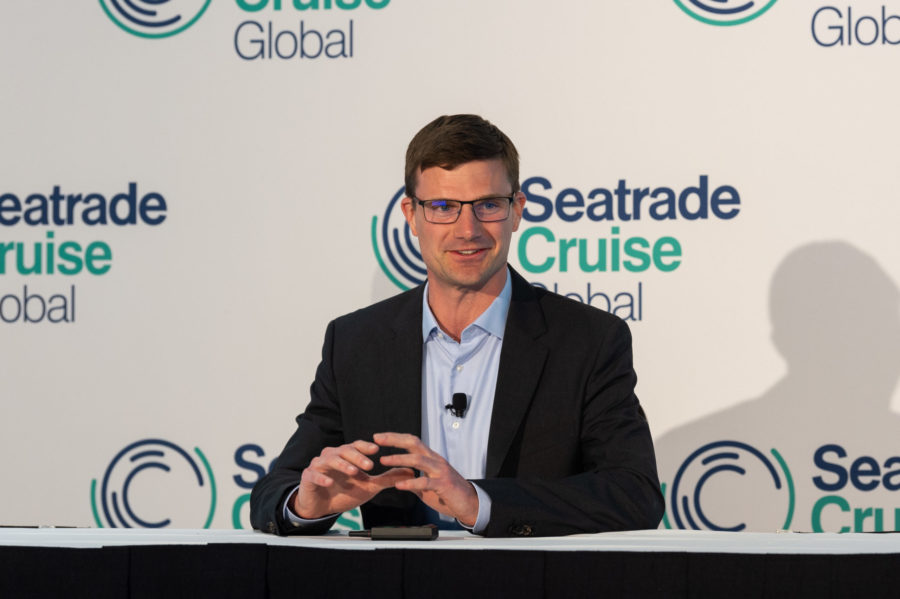
President:CEO Charles B. Robertson talks about American Cruise Lines’ Project Blue. * Photo: Seatrade Cruise Global
Its “go anywhere” coastal vessels sport a catamaran design, giving access to small ports and shallow-water rivers, bays and lakes.
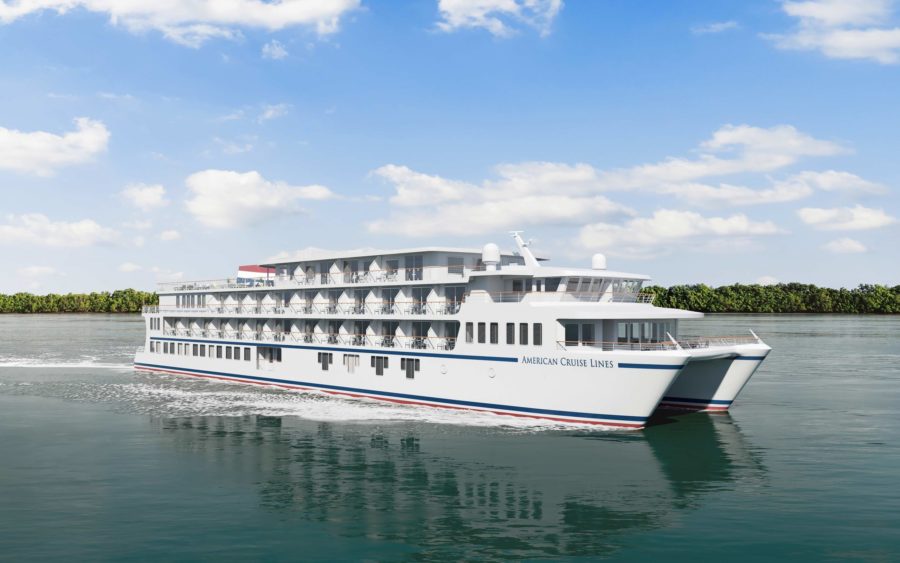
American Cruise Lines’ next-generation Project Blue design. * Rendering: American Cruise Lines)
The first of what’s planned to be a dozen Project Blue ships, American Eagle and American Glory, are to debut in 2023.
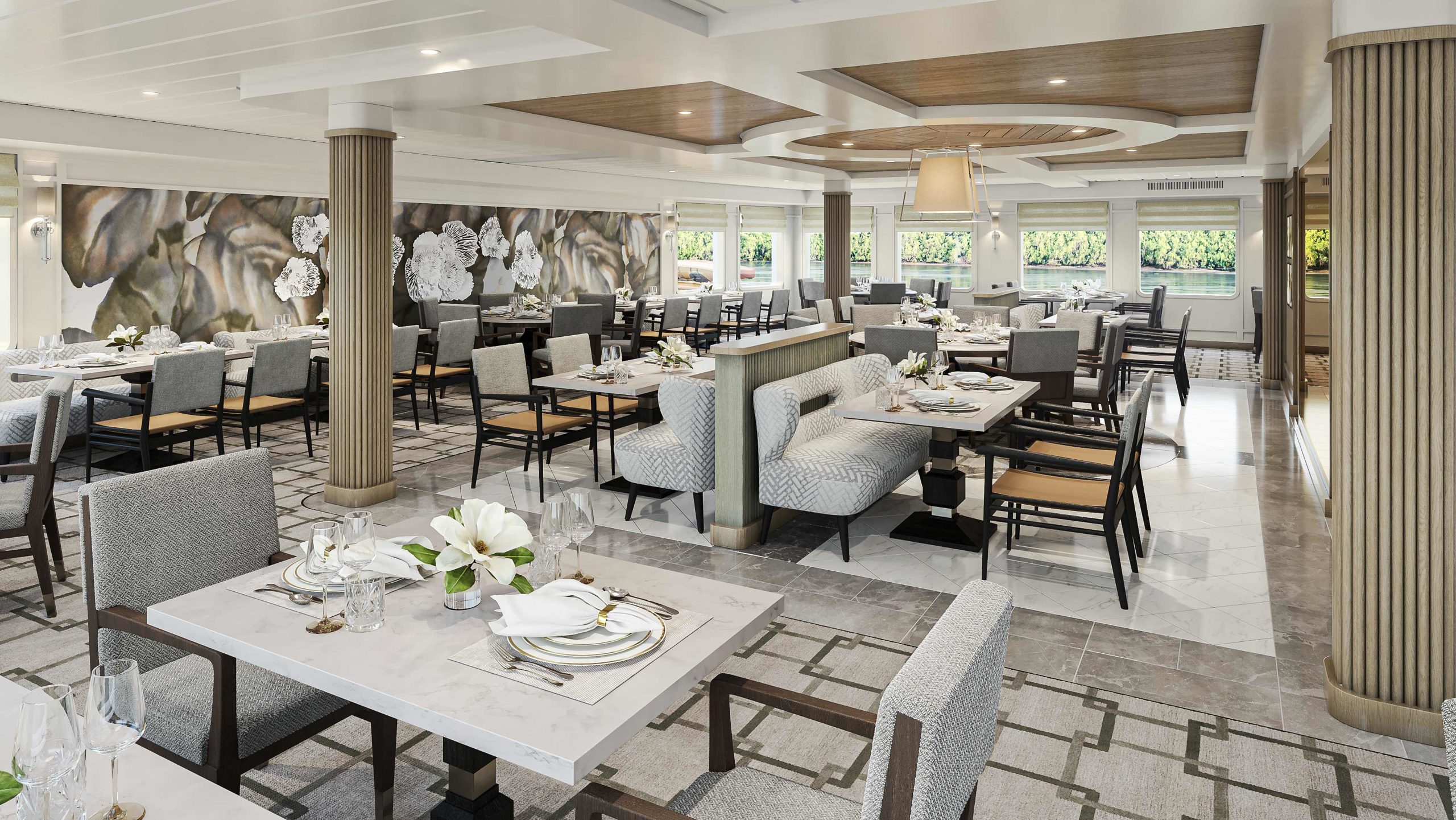
The elegant restaurant on American Cruise Lines’ new American Eagle, part of its Project Blue series. * Rendering: American Cruise Lines
Ponant’s new CEO, Hervé Gastinel, made his first Seatrade appearance and talked about plans for a carbon neutral ship design, which the company hopes to detail later in 2022.
SeaDream Yacht Club shared images of upgrades to staterooms, suites and public areas completed on its twin yachts, a $10 million investment.
Conference Sessions
Small-ship lines were also represented in numerous Seatrade conference sessions, including “Small but Special: A Focus on Small Ships and River Cruising,” “Hybrid Luxury – Expedition Cruising,” several expedition-specific panels and “Bucket-list Voyages: Delivering Unforgettable Itineraries and Experiences.”
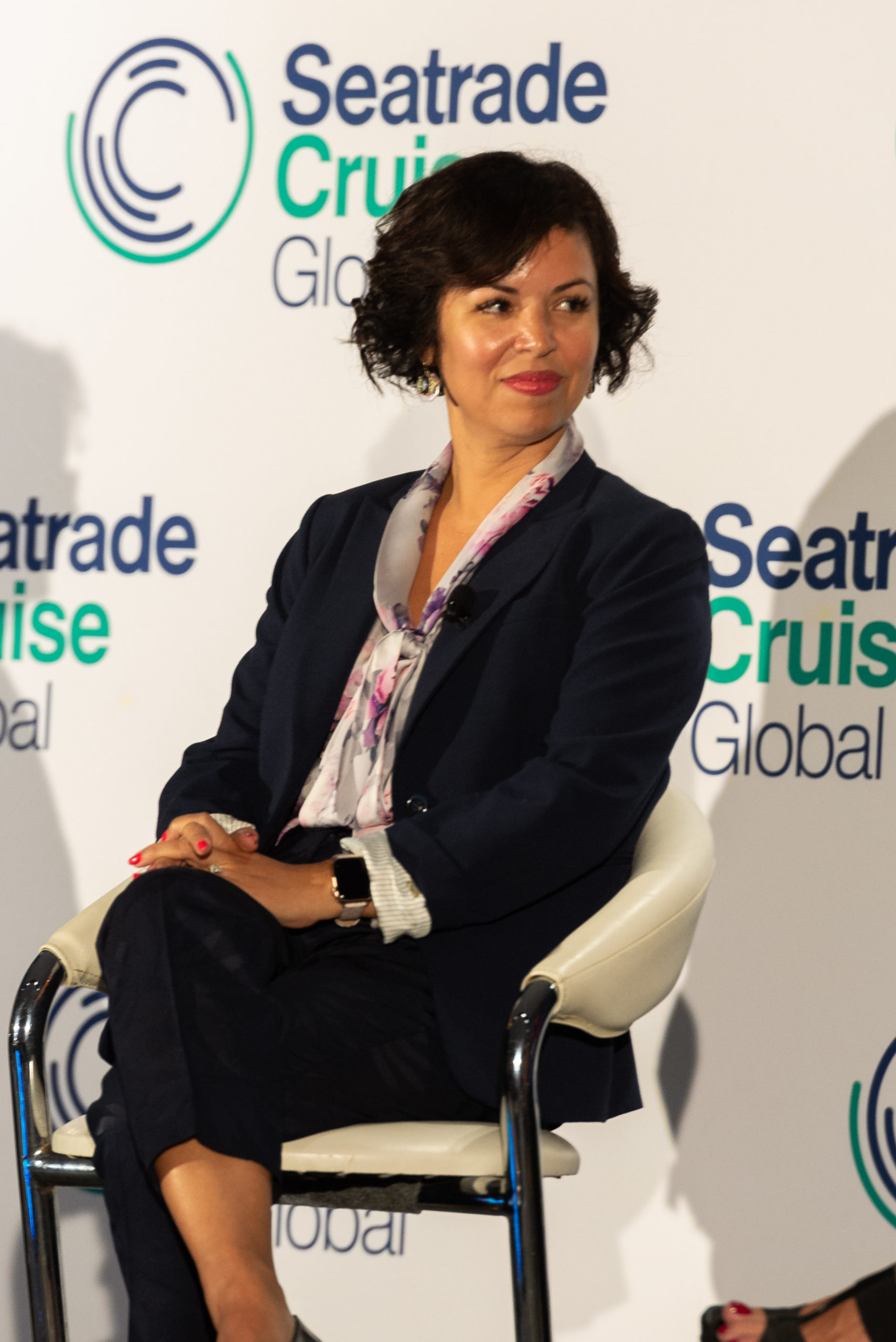
Isis Ruiz of American Queen Voyages on a panel. * Photo: Seatrade Cruise Global
Executives from small-ship lines also participated as speakers in panels on luxury cruising, European cruising, strategic thinking; diversity, equity and inclusion; marketing, public relations/communications; and recruitment challenges and opportunities.
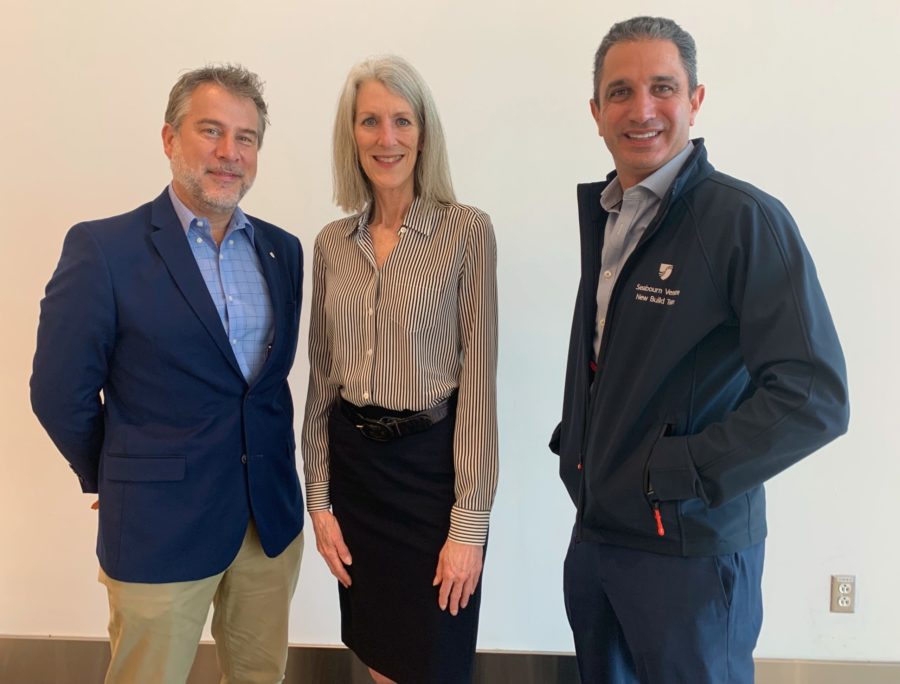
Seabourn’s Gerald Mosslinger, left, and Josh Leibowitz, right, with reporter Anne Kalosh
Small But Special
River/coastal line American Queen Voyages talked about newly introduced destinations like Mexico’s Yucatán and the Southeast U.S., and branching into expedition cruising with its new Ocean Victory ship in Alaska this summer.
Variety Cruises said it wants to become the first cruise operator to accept cryptocurrency.
And Windstar Cruises recapped its $250 million Star Plus initiative that cut its three motor yachts in half, added midsections, re-engined the vessels to add speed and efficiency and created new suites, restaurants and outdoor venues.
Last week, with the introduction of the final ship to be “stretched,” Star Pride, Windstar announced its full fleet was back in service — that’s six vessels — culminating a ramp-up following the pandemic shutdown.
Recruiting Challenges
Staffing and recruiting challenges are impacting the cruise business, part of a pandemic-induced labor shortage and issues like passport and visa processing delays in many countries. This meant some ships were delayed returning to service, and some are not yet able to offer full services onboard. For example, not all specialty dining venues may be open.
While many cruise industry workers were laid off, furloughed or quit during the cruise shutdown, “We’re at even more risk now” for losing talent, warned Camille Drevillon, SVP strategic planning and business development, Abercrombie & Kent, in a Seatrade session on recruitment.
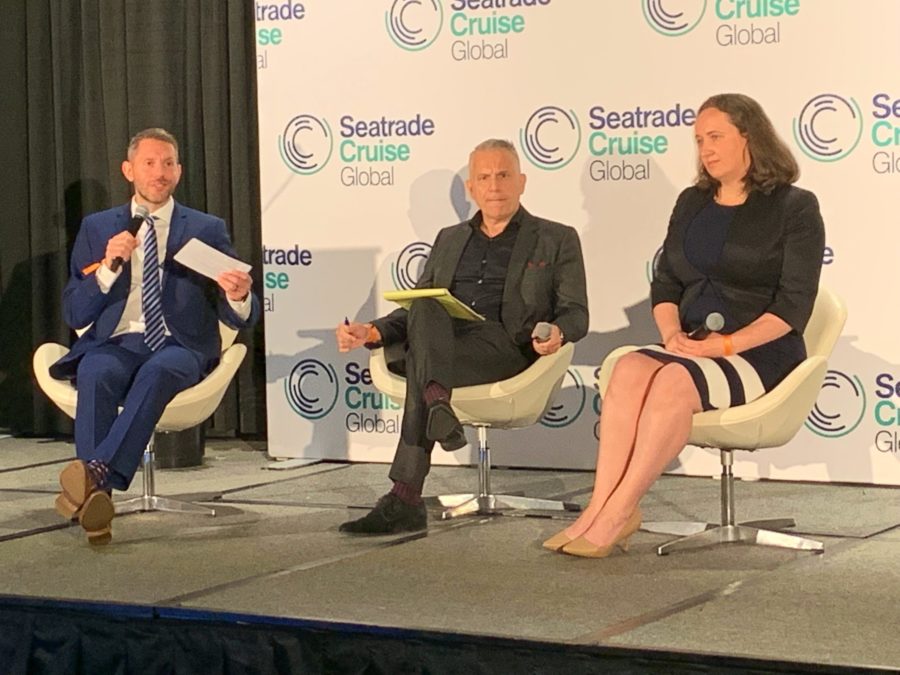
A panel on recruitment challenges with Faststream’s Martin Bennell, left, CMI Ship Management’s Jim Barreira de Leon and Abercrombie & Kent’s Camille Drevillon. * Photo: Anne Kalosh
People who soldiered through the pandemic had to work even harder, without extra reward.
And it’s tough for travel-sector employers to raise pay after two years of diminished revenue with recovery still under way.
New Faststream Recruitment research revealed at the session found that 50 percent of the shoreside workers and 82 percent of the shipboard workers — of 1,011 surveyed — plan to look for a new job in the next 12 months. Only 38 percent feel very valued by their employer.
Salary and benefits are the biggest motivation for crew to change jobs while, for shoreside employees, better work-life balance is desired. According to Faststream, 61 percent desire a hybrid work style.
The survey uncovered that half the shoreside workers and 66 percent of those at sea are concerned about job security.
Jim Barreiro de Leon, president and CEO, CMI Ship Management, which manages 12 ships in the expedition segment, said seafarers rank No. 14 on the list of essential workers. “It’s insane. We have a lot of work to do to put programs in place to make sure this [pandemic disregard for seafarers] doesn’t happen again.”
Barreiro de Leon offered some ways to better conditions for seafarers, including improving the onboard culture, mental health programs, better benefits and effective mentorship. Also, seafarers want health benefits to extend to their families at home, something the CMI chief said is actually not that cost-prohibitive. His company also tries to provide salaries when crew are on leave by giving them work in port operations or other areas.
Shoreside, retention is a “huge issue” across travel companies, according to A&K’s Drevillon. People who’ve worked in travel are very attractive because so many of their skills are marketable in other industries.
Millennials (ages 27 to 41) are now in mid-level management. And for them, important factors are having a voice, company values that align with their own (one of the issues they care about is sustainability) and making a difference. They’re also tech savvy and know how to market themselves.
“It’s very easy to convince them to jump jobs,” Drevillon said, especially when they can earn much more in non-travel sectors.
Expedition Cruising
Russia’s war in Ukraine is “definitely not helping” expedition cruising but things could be worse, Silversea Cruises CEO Roberto Martinoli said. The Russian Far East is off-limits, and people who don’t know geography very well may be avoiding areas that aren’t actually troublesome. But there are plenty of other places to go.
The impact on Ukrainian crew, though, is “heart-wrenching,” Seabourn President Josh Leibowitz said. “One woman left her country and kids in order to keep working [onboard]. The impact is, first and foremost, on people.”
During the pandemic, fielding small ships in remote destinations was an advantage because people wanted to be away from the crowds. Though that presented operational challenges, travelers booking bucket-list destinations like Antarctica didn’t cancel as much, and Silversea’s Antarctic trips had the best load factors of the fleet, Martinoli said.
“This business is capacity-constrained,” according to Leibowitz, explaining there’s a desire for extreme luxury experiences from a market consisting of a few million people, while just a few thousand expedition cruise berths exist.
Seabourn is due to add its first purpose-built expedition ship this year, with the 264-passenger Seabourn Venture now expected to debut July 27 following four shipbuilding delays, and sister Seabourn Pursuit to follow in 2023.

Seabourn’s first purpose-built expedition ship, Venture, is nearing completion after several delays. At far right, Seabourn President Josh Leibowitz. * Photo: Seabourn
But it’s the destinations driving demand, not the new ships, according to Martinoli, who said: “We had our smallest and oldest ship in the Galápagos and it got the best passenger feedback because the destination is phenomenal. The destination prevails over everything else.”
That ship was replaced in 2021 with the purpose-built Silver Origin. “When you improve the assets, it makes the passengers more comfortable,” Martinoli added. “It helps, but the destination is paramount.”
Expeditions enlarge the customer base for luxury cruising, the speakers said. Expedition cruisers are affluent, yes, but psychographics are more relevant than demographics, according to Leibowitz. Seabourn’s Antarctica travelers range from young people who made a lot of money in the tech sector to families and people in their 50s or 60s who’ve always dreamed of going.
“We had a 104-year-old out on the Zodiac bow, photographing penguins,” Martinoli said. But younger people and more children taking expedition trips. In the recent season, Silversea’s new “Antarctica Bridge” program that flies cruisers to embark the ship in Antarctica, skipping the Drake Passage, attracted younger, wealthy people with less time to be away.
Operating in a sustainable way is critical — and expedition lines are meticulous about that, Martinoli said, but the public often doesn’t know or has the wrong impression. More proactive communications are needed to tell a more accurate story.
While polar regions have been the mainstay for expeditions, the destinations are diversifying to include places like Tahiti and Western Australia’s Kimberley, where there’s so much to do with the exploration tools on today’s ships, Leibowitz pointed out.
Seatrade session moderator Capt. Ben Lyons, CEO of EYOS Expeditions and a contributing writer to QuirkyCruise, asked if there’s still room for the small, independent operators who’ve traditionally defined expedition cruising?
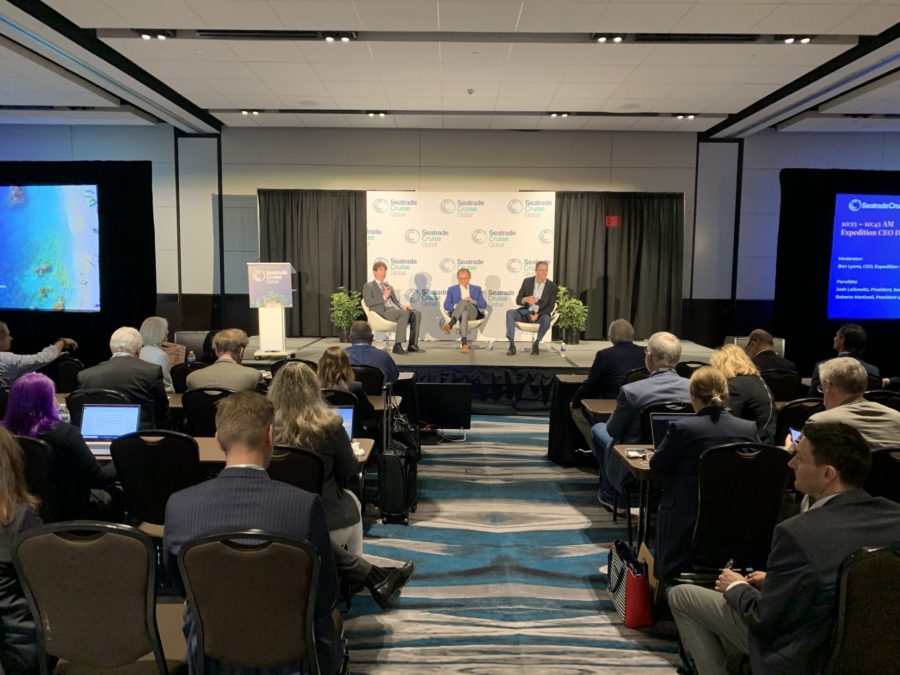
Capt. Ben Lyons, a QuirkyCruise contributor, moderates one of the expedition cruising sessions. * Photo: Anne Kalosh
There is, Martinoli and Leibowitz agreed, but the independents’ biggest challenge is distribution so being part of a larger public company is a huge advantage.
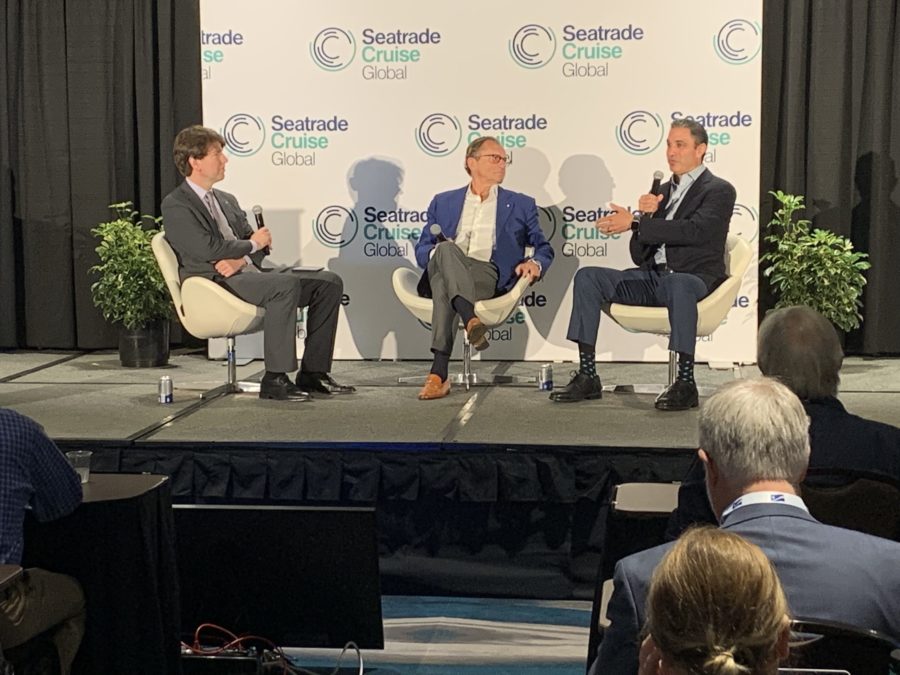
Seabourn President Josh Liebowitz makes a point in one of the expedition cruising sessions. At left is Capt. Ben Lyons of EYOS Expeditions, with Silversea’s Roberto Martinoli at center. * Photo: Anne Kalosh
Last week, both Seabourn and Silversea announced their full fleets — five ships for Seabourn and 10 for Silversea — had returned to passenger service.
It’s also been reported recently that Seabourn’s parent company, Carnival Corp. & plc, was in early talks to sell Seabourn to Saudi Arabia’s sovereign wealth fund, PIF. CNBC cited unnamed “people familiar with the situation” and had no comment from the Saudis or Carnival.
PIF bought into Carnival Corp. in 2020, and today holds a 5.14 percent stake.
Last year PIF officially launched Cruise Saudi to establish the cruise industry there and create a new destination for international lines via a network of ports. It is drawing a growing number of homeport and transit calls, including boutique brands like Scenic and Emerald.
As earlier reported here, Cruise Saudi is also involved in a joint venture with Aman Resorts to develop a 100-passenger yacht. And, in 2020, the Saudis chartered Silversea’s Silver Spirit for two months of Red Sea cruises marketed domestically.
RELATED: A Round-Up of Private Hotel Yachts
New Destinations & Authenticity
At Seatrade’s “Hybrid Luxury – Expedition Cruising” session, speakers echoed Roberto Martinoli’s emphasis on desinations. And small-ship fans — who tend to be well-traveled and on the lookout for discoveries — will be glad to hear that lines continue their quest for new and authentic places.
Zeljka Cimic, product development manager, ocean cruising, Scenic Luxury Cruises & Tours, told attendees, according to reporting by Seatrade’s Holly Payne, that her company seeks new ports. Cimic said large ports “have been pushed aside now. We are really looking for off the beaten track ports” that, for example, “only accept one cruise ship per day and 100 to 200 passengers.”
Cimic continued: “We are not looking for something special. What you have is special, what you have is enough. Your destination is perfect as it is.”
This view on authenticity was endorsed by Conrad Combrink, SVP expeditions, tour operating and destination management, Silversea, who said today’s luxury travelers are collecting experiences, not things.
“We’re looking for something that allows passengers to really understand a destination, that they’re not just going to touch the surface,” added Jen Martin, director of expeditions, Seabourn.
Luxury Immersion
In a luxury session, destination immersion was a focus, according to a report by Seatrade contributing writer Tom Stieghorst.
At The Ritz-Carlton Yacht Collection, CEO Doug Prothero cited the line’s Patron of the Arts program, which invites artists, speakers and cultural contributors from destinations aboard the ships for performances, demonstrations and lectures.
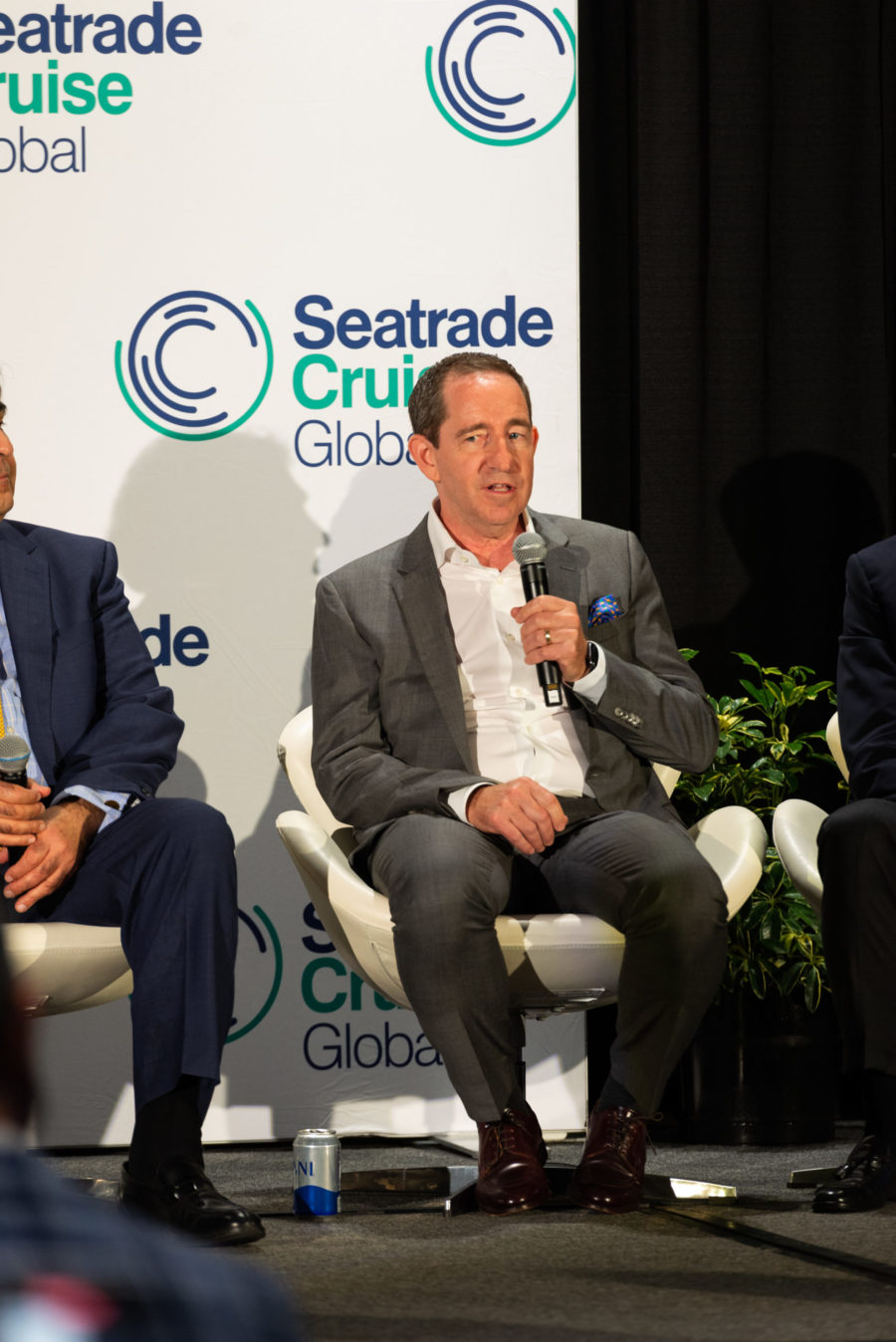
The Ritz-Carlton Yacht Collection CEO Douglas Prothero on a luxury cruise panel. * Photo: Seatrade Cruise Global
“We’ve been doing plenty of things on shore,” Prothero said, but almost nothing onboard the ships. “This is the other frontier for this [type of] traveler.”
Just last week, it was announced that the company’s first yacht, Evrima, had completed sea trials. The long-delayed vessel is scheduled to enter service in August.
In the luxury session, Ponant Americas CEO Navin Sawhney pointed to a navigation program for Ponant’s icebreaker, Le Commandant Charcot, as his example of destination immersion. For visits to the High Arctic, his company developed a presentation with Inuit communities on traditional ways of navigating the ice.
Sawhney also cited Ponant’s Smithsonian Journeys excursion series curated by the famed Smithsonian Institution; one such excursion in the Baltic features former Polish President and Nobel Peace Prize laureate Lech Wałęsa talking about his Solidarity labor movement that played a key role in ending Communism there.
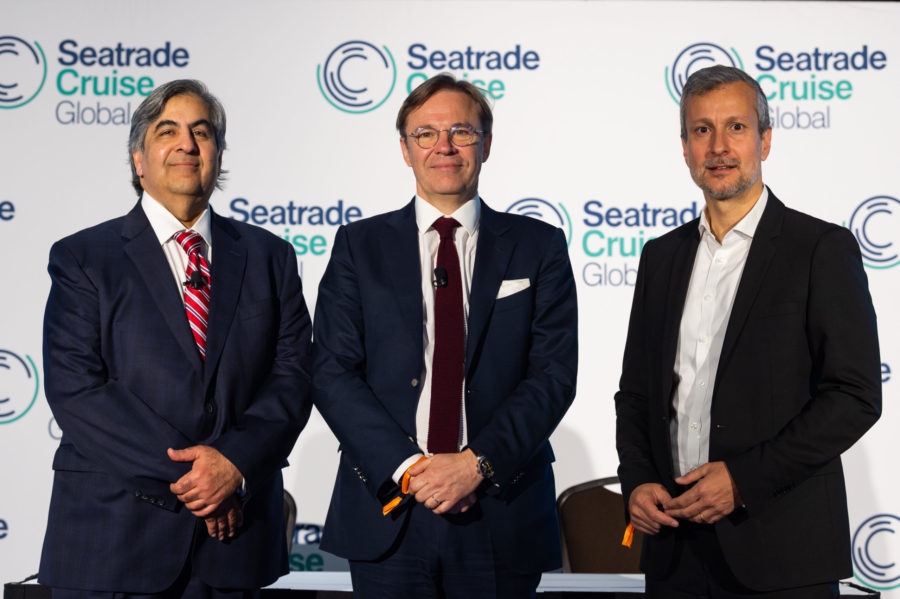
Ponant had a strong presence with top executives including its new new CEO, Hervé Gastinel, center, with Navin Sawhney, left, and Hervé Bellaiche. * Photo: Seatrade Cruise Global
A&K’s Pitcairn Encounter
Abercrombie & Kent also had a strong representation at Seatrade — in part because of researching destinations and tours as the company, now in its 60th year, is expanding its luxury expedition cruises for 2023-24 to all seven continents. This includes new itineraries in Europe, Africa and across the South Pacific.
“More than ever before, travelers are looking for immersive experiences — whether alongside a marine biologist in the Arctic, an Aboriginal culture expert in Western Australia or a former NASA astronaut in the most remote regions of the Pacific,” said A&K’s Bob Simpson, VP expedition cruising.

Abercrombie & Kent’s Bob Simpson. * Photo: Anne Kalosh
In an interview, Simpson pointed to the 2023 “French Polynesia to Easter Island” expedition he’s planning. It embarks in Tahiti and traverses the Tuamotu Archipelago, the Gambier Islands and Pitcairn Islands before ending at Easter Island.
This journey on Ponant’s Le Boréal features guest lecturer Susan Kilkrain, former NASA space shuttle commander. Her first mission was tied to Easter Island, also home to an emergency landing runway for NASA.
The remote Pitcairn Islands, whose population is descended from the mutineers of the HMS Bounty and their Tahitian consorts, numbers around 50.
To Simpson’s surprise, who should he run into during Seatrade? Pitcairn tourism travel coordinator Heather Menzies.
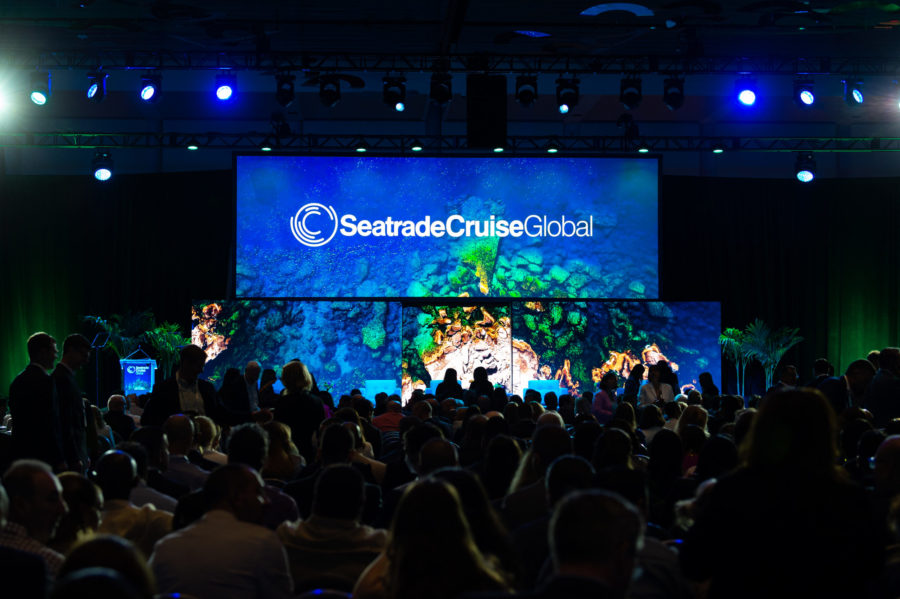
Seatrade Cruise Global main stage.
Don’t miss a post about small-ship cruising, subscribe to QuirkyCruise.com for monthly updates & special offers!
© This article is protected by copyright, no part may be reproduced by any process without written permission from the author. All Rights Reserved. QuirkyCruise.com.

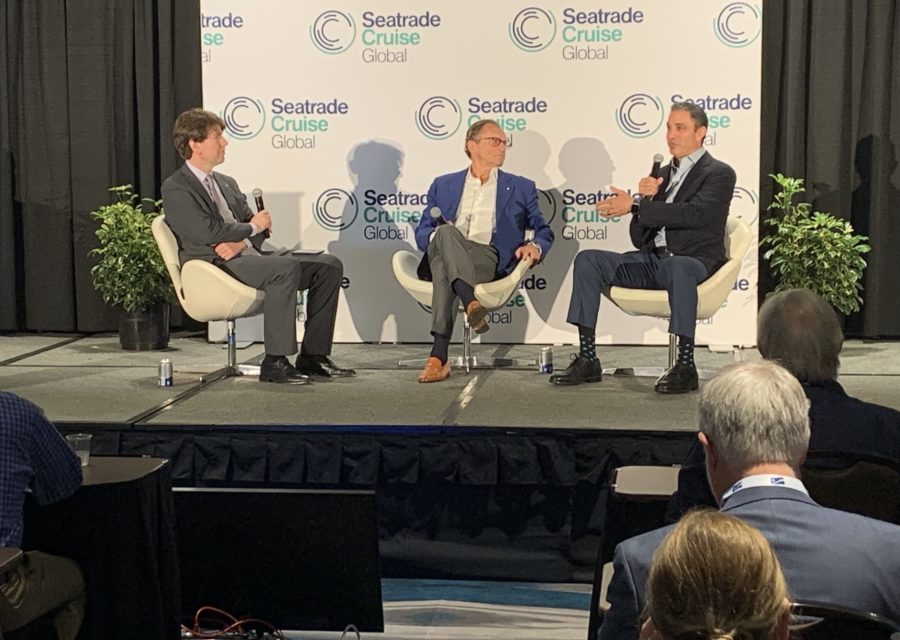
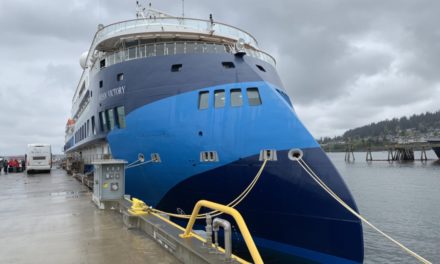
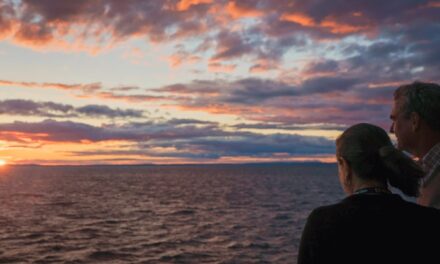
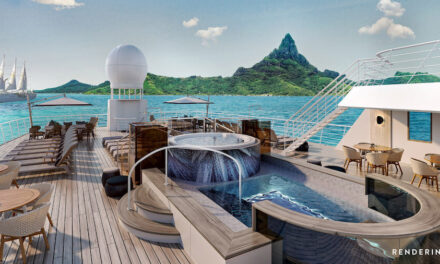
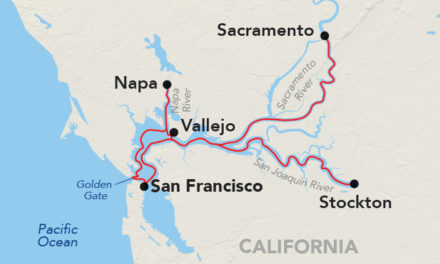








 HEIDI SARNA
HEIDI SARNA











